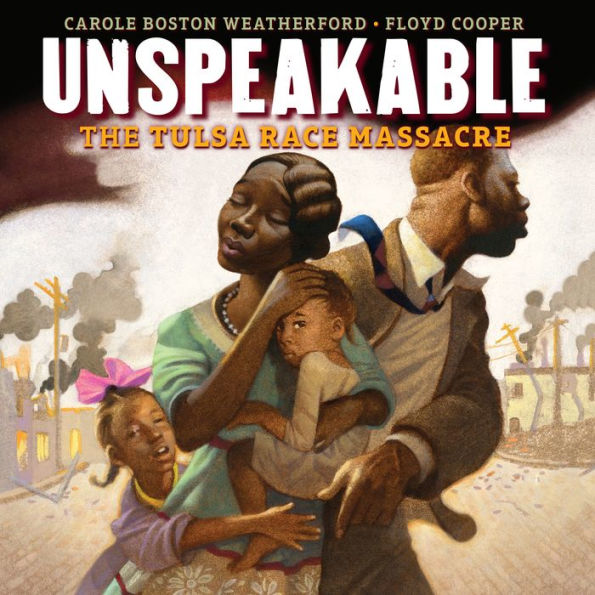Publishers Weekly
★ 01/04/2021
Without glossing over important facts, Weatherford (Dreams for a Daughter) tells the historical events of the 1921 Tulsa Race Massacre in language appropriate for young readers. Rhythmic free verse text highlights a thriving community in segregated Tulsa: prosperous Greenwood, also known as Black Wall Street, had “nearly two hundred businesses in all,” including two Black-owned newspapers and 15 Black doctors. Using oil and erasure to form spare backgrounds and realistic, detailed portraits, Cooper’s (Sprouting Wings) illustrations pull readers through the events, beginning with a white woman accusing a Black man of assault and resulting in his arrest, an inflammatory headline that incited an angry white mob, and the mob’s subsequent massacre of Black citizens and burning of the entire Greenwood neighborhood. By focusing not just on the attack, but also on the positive achievements of the Black business owners, lawyers, and doctors of Greenwood, the book succeeds in teaching the tragedy of the Tulsa Race Massacre and the legacy of Black Wall Street. An author’s note explains the impact of the event and a subsequent cover-up by the city. Ages 9–10. Author’s agent: Rubin Pfeffer, Rubin Pfeffer Content. (Feb.)■
From the Publisher
"This moving account sheds light on shameful events long suppressed or ignored. All collections should consider this title's value in providing historical context to current conversations about racism and America's ongoing legacy of white supremacy."—starred, School Library Journal
School Library Journal
★ 02/01/2021
Gr 3–6—One hundred years ago, the Greenwood district of Tulsa, OK, was a prosperous Black community. Restaurants, beauty salons, movie theaters, and dozens of other businesses thrived along "Black Wall Street." Cooper's sepia-tone illustrations depict the bustle of everyday life as people hurried to shops or churches and gathered with friends. A stark spread signals the tragic turning point that resulted in the decimation of Greenwood's Black community. A 17-year-old white woman elevator operator accused a 19-year-old Black man of assault. Incited by calls to action printed in white-owned newspapers, thousands of armed white men headed to the jail, where they met 30 armed Black men determined to stop a lynching. The confrontation resulted in the deaths of two Black men and 10 white men. Angry that they didn't get to the jailed Black man, a white mob invaded the town, looted, and committed arson. The police did nothing to protect the Black citizens. Up to 300 Greenwood residents were killed, and more than 8,000 were left homeless. Seventy-five years passed before an official investigation occurred. Cooper's illustrations are infused with a personal connection. Not only did he grow up in Tulsa, but Cooper also heard his grandpa's stories of surviving the events. The powerful photo spread on the endpapers documents the destruction and smoking ruins. Cooper's final illustrations of Tulsa's Reconciliation Park offer a bit of hope. Weatherford's author's note provides additional background. VERDICT This moving account sheds light on shameful events long suppressed or ignored. All collections should consider this title's value in providing historical context to current conversations about racism and America's ongoing legacy of white supremacy.—Kathy Piehl, Minnesota State Univ. Lib., Mankato
JULY 2021 - AudioFile
Music and sound effects accentuate the moods in this nonfiction picture book about the Tulsa Race Massacre of 1921. January LaVoy narrates with a range of emotions. She opens cheerfully, detailing the thriving Black community’s prosperity, reading the repeated refrains: “Once upon a time in Greenwood . . .” and “Once upon a time on Black Wall Street . . .” City sounds and bright music play. Then the listener hears the ominous thud of an elevator landing and its metal grate opening—the beginnings of a racially motivated massacre. Tense music and the sounds of chaos punctuate the ensuing violence. Against a background of discordant music, LaVoy somberly details the aftermath—hundreds dead, thousands homeless, Greenwood in ruins. Her voice turns optimistic, however, reading the author’s exhortation to “choose hope.” The author reads the illustrator’s and author’s notes. L.T. Winner of AudioFile Earphones Award © AudioFile 2021, Portland, Maine
Kirkus Reviews
★ 2020-11-18
A once-thriving Black community was destroyed, and the story of how it happened went untold for decades.
In the beginning of the 20th century, Tulsa, Oklahoma, was emerging as a thriving oil town, and African Americans worked to establish communities in the face of discrimination. The separate neighborhoods that grew out of segregation meant that Black businesses sprang up to serve those who could not frequent White establishments. The African American neighborhood of Greenwood had so many it became known as “Black Wall Street,” with an impressive range of services and opportunities. The tenuous nature of Black prosperity was reinforced, however, when a White woman accused a Black man of assault. White mobs, unable to reach the suspect, descended on Greenwood, looting the businesses and burning the community to the ground. With no protection or assistance from law enforcement, all that the residents had achieved was lost. Further, it took 75 years before an official investigation was launched. Author Weatherford and illustrator Cooper join forces to present this important story with sensitivity and care for younger readers. Weatherford’s measured prose depicts the events in a cleareyed, age-appropriate narrative. Oklahoma native Cooper’s muted palette and oil-erasure style effectively portray first the achievement and then the devastation that followed. The author’s and illustrator’s notes provide valuable insight and context, as does the rear endpapers’ photograph of the massacre’s aftermath.
A somber, well-executed addition to the history as the incident approaches its 100th anniversary. (Informational picture book. 8-12)



